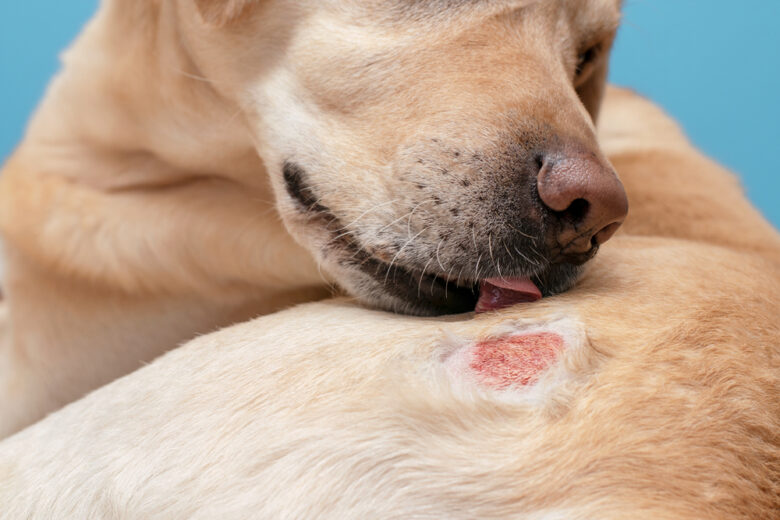For many pet owners, dog allergies are a year-round problem, not just during certain times of the year. Allergies can have a major impact on your dog’s health and well-being. They can occur in a variety of ways, from skin irritations to stomach problems. Every dog owner needs to understand the different types of dog allergies, what causes them, how to treat them and what symptoms they may have. This comprehensive guide describes the complexities of dog allergies and provides readers with helpful information on how to diagnose, treat, and avoid them.
Types of Allergies in Dogs:
Just like people, dogs can have different types of allergies, each with their own symptoms and causes. Environmental, food, flea allergy dermatitis (FAD), and contact allergies are the main types.
- Environmental Allergies
Airborne allergens, such as pollen, mold, dust mites and hair, can cause environmental allergies, also known as atopic dermatitis. Depending on the dog’s sensitivity and how common the allergen is, these allergies can make the dog uncomfortable at certain times of the year or all year round.
- Food Allergy
Despite what most people think, food allergies do not cause many cases of dog allergies. Protein, on the other hand, is often the culprit behind pain. Finding bad food and throwing it away is important for comfort.
- Flea Allergy Dermatitis (FAD)
People with FAD are highly allergic to flea bites, especially the proteins in flea saliva. In dogs with allergies, even one bite can cause a severe allergic reaction, causing them to scratch frequently, develop skin diseases and lose their hair.
- Contact Allergies
Contact allergy is the least common form of allergy. This happens when a dog’s skin reacts severely to irritants, such as certain fabrics, rubber, plastic, or even shampoo and cleaning products.
Signs Your Dog Is Allergic:
Dogs can develop allergic reactions in several ways, but the main ones affect the skin, lungs and digestive system. Red or itchy skin, sneezing, coughing, watery eyes, vomiting and diarrhea are all common symptoms. If your dog has frequent ear infections or changes in his behavior, such as increased licking or scratching, he may have allergies.
Check If Your Dog is Allergic:
To find out if your dog has allergies, your vet will need to perform a thorough examination to determine the dog’s full history of symptoms and may even perform specific tests, such as skin or blood allergy testing. People with food allergies may need to try an elimination diet to find the foods that are causing symptoms.
Caring for and Treating Dog Allergies:
The effectiveness of treating and controlling hypersensitivity in dogs depends on the type of allergy and the cause of the allergy. Although it is best to avoid known allergens, there are medications and home remedies that can help.
- Environmental Allergy
Ways to control environmental allergies may include bathing regularly with hypoallergenic or medicated shampoo to remove allergens from the skin, using an air purifier, and, in some cases, giving recommended medications such as antihistamines, corticosteroids, or immunotherapy.
- Food Allergy
To treat a dog’s food allergy, you need to find the food that is causing the allergy and remove it from the diet. This may mean feeding them a diet with limited ingredients or prescribing hypoallergenic foods to reduce the risk of allergic reactions.
- Flea Allergy Dermatitis
Keeping an escaped dog away from the dog and its environment is the most important thing you can do to stop FAD. Available treatments include topical or oral flea preventatives, anti-inflammatory medications to relieve itching, and antibiotics to treat secondary skin conditions.
- Contact Allergies
Finding and eliminating the cause of the allergy is part of the treatment of contact allergies. This may mean changing your dog’s environment, such as switching to hypoallergenic bedding, staying away from certain grooming products, or cutting out certain detergents.
Naturopathic and Home Remedies:
Some dog owners believe that natural remedies can help relieve their pets’ allergy symptoms. For example, oatmeal baths can help soothe red and itchy skin, omega-3 pills can improve skin health, and eating more coconut oil can help reduce inflammation. However, before trying at-home treatments, consult your vet to ensure they are safe and appropriate for your dog.
How to Stop Dog Allergies:
Some external and genetic factors may prevent you from completely avoiding allergens, but limiting your exposure to allergens and eating a good diet can help manage your symptoms. Additionally, it is important to take your pet to the vet regularly for early detection and treatment of allergy-related problems.
Conclusion:
To understand the complex world of dog allergies, you need to know all the types, symptoms and treatment options. By catching signs of allergies early and working closely with their veterinarian, pet owners can successfully manage their dog’s allergies and ensure their furry friends live happy and healthy lives. The best way to deal with dog allergies is to be responsible and fully informed about caring for your pet, whether that means seeking medical attention, changing your lifestyle or using natural remedies.
FAQs:
1. What are the most common types of allergies in dogs?
The most common types of allergies in dogs are environmental allergies (atopic dermatitis), food allergies, flea allergy dermatitis (FAD), and contact allergies. Each type has unique triggers, such as airborne allergens, specific food ingredients, flea saliva, or direct contact with irritants.
2. How do I know if my dog has allergies?
Allergy symptoms in dogs vary widely but often include excessive itching and scratching, red or inflamed skin, chronic ear infections, sneezing, coughing, watery eyes, vomiting and diarrhea. If you notice any of these symptoms, consult your vet for a proper diagnosis.
3. Can dog food allergies be cured?
While it is impossible to “cure” food allergies, you can effectively manage them by locating and removing dangerous allergens from your dog’s diet. This usually involves feeding a limited-ingredient diet or a prescription hypoallergenic diet under the guidance of a veterinarian.
4. What is flea allergy dermatitis? How to treat?
Flea allergy dermatitis (FAD) is an allergic reaction to flea bites, particularly flea saliva. Treatment involves strict flea control measures to prevent flea bites, including the use of topical or oral flea preventatives, and may also include medications to relieve itching and inflammation, and antibiotics to treat any secondary skin infections.
5. Are there natural treatments for dog allergies?
Some natural remedies for dog allergies include oatmeal baths to soothe irritated skin, omega-3 fatty acid supplements to improve skin health, and coconut oil for its anti-inflammatory properties. However, it is crucial to consult your vet before trying any home remedies to ensure they are safe and appropriate for your dog’s specific situation.



